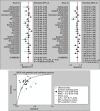Does Neutrophil-to-lymphocyte Ratio at Admission Predict Severity and Mortality in COVID-19 Patients? A Systematic Review and Meta-analysis
- PMID: 35519918
- PMCID: PMC9015924
- DOI: 10.5005/jp-journals-10071-24135
Does Neutrophil-to-lymphocyte Ratio at Admission Predict Severity and Mortality in COVID-19 Patients? A Systematic Review and Meta-analysis
Abstract
Background: Coronavirus disease-2019 (COVID-2019) pandemic continues to be a significant public health problem. Severe COVID-19 cases have a poor prognosis and extremely high mortality. Prognostic factor evidence can help healthcare providers understand the likely prognosis and identify subgroups likely to develop severe disease with increased mortality risk so that timely treatments can be initiated. This meta-analysis has been performed to evaluate the neutrophil-to-lymphocyte ratio (NLR) at admission as a prognostic factor to predict severe coronavirus disease and mortality.
Materials and methods: A literature search was conducted through April 30, 2021, to retrieve all published studies, including gray literature and preprints, investigating the association between NLR and severity or mortality in COVID-19 patients. Screening of studies and data extraction have been done by two authors independently. The methodological quality of the included studies was assessed by the Quality in Prognosis Studies (QUIPS) tool.
Results: Twenty-four studies involving 4,080 patients reported the prognostic value of NLR for severe COVID-19. The pooled sensitivity (SEN), specificity (SPE), and area under the curve were 0.75 (95% CI 0.69-0.80), 0.74 (95% CI 0.70-0.78), and 0.81 (95% CI 0.77-0.84). Fifteen studies involving 4,071 patients reported the prognostic value of NLR for mortality in COVID-19. The pooled sensitivity (SEN), specificity (SPE), and area under curve were 0.80 (95% CI 0.72-0.86), 0.78 (95% CI 0.69-0.85), and 0.86 (95% CI 0.83-0.89).
Conclusion: The prognostic value of NLR at admission for severity and mortality in patients with COVID-19 is good. Evaluating the NLR at admission can assist treating clinicians to identify early the cases likely to worsen. This would help to conduct early triage, identify potentially high-risk cases, and start optimal monitoring and management, thus reducing the overall mortality of COVID-19.
Trial registry: This meta-analysis was prospectively registered on PROSPERO database (Registration Number: CRD42021247801).
How to cite this article: Sarkar PG, Pant P, Kumar J, Kumar A. Does Neutrophil-to-lymphocyte Ratio at Admission Predict Severity and Mortality in COVID-19 Patients? A Systematic Review and Meta-analysis. Indian J Crit Care Med 2022;26(3):361-375.
Keywords: COVID-19 ARDS; COVID-19 mortality; Neutrophil-to-lymphocyte ratio; Prognosis.
Copyright © 2022; Jaypee Brothers Medical Publishers (P) Ltd.
Conflict of interest statement
Source of support: Nil Conflict of interest: None
Figures






Similar articles
-
Predictive values of neutrophil-to-lymphocyte ratio on disease severity and mortality in COVID-19 patients: a systematic review and meta-analysis.Crit Care. 2020 Nov 16;24(1):647. doi: 10.1186/s13054-020-03374-8. Crit Care. 2020. PMID: 33198786 Free PMC article.
-
Neutrophil-to-lymphocyte ratio on admission to predict the severity and mortality of COVID-19 patients: A meta-analysis.Am J Emerg Med. 2021 Apr;42:60-69. doi: 10.1016/j.ajem.2021.01.006. Epub 2021 Jan 9. Am J Emerg Med. 2021. PMID: 33453617 Free PMC article.
-
The Impact of Neutrophil-Lymphocyte Count Ratio in COVID-19: A Systematic Review and Meta-Analysis.J Intensive Care Med. 2022 Jul;37(7):857-869. doi: 10.1177/08850666211045626. Epub 2021 Oct 21. J Intensive Care Med. 2022. PMID: 34672824 Free PMC article.
-
Neutrophil-to-lymphocyte Ratio and Platelet-to-lymphocyte Ratio as Markers for Predicting the Severity in COVID-19 Patients: A Prospective Observational Study.Indian J Crit Care Med. 2021 Aug;25(8):847-852. doi: 10.5005/jp-journals-10071-23906. Indian J Crit Care Med. 2021. PMID: 34733022 Free PMC article.
-
Neutrophil-Lymphocyte Ratio in Patients with COVID-19 as a Simple Tool to Predict Requirement of Admission to a Critical Care Unit.Indian J Crit Care Med. 2021 May;25(5):535-539. doi: 10.5005/jp-journals-10071-23801. Indian J Crit Care Med. 2021. PMID: 34177173 Free PMC article.
Cited by
-
The Role of Neutrophil-to-Lymphocyte Ratio in Risk Stratification and Prognostication of COVID-19: A Systematic Review and Meta-Analysis.Vaccines (Basel). 2022 Aug 1;10(8):1233. doi: 10.3390/vaccines10081233. Vaccines (Basel). 2022. PMID: 36016121 Free PMC article. Review.
-
Reevaluation of prognostic and severity indicators for COVID-19 patients in the emergency department.Ann Med. 2024 Dec;56(1):2417178. doi: 10.1080/07853890.2024.2417178. Epub 2024 Oct 22. Ann Med. 2024. PMID: 39435611 Free PMC article.
-
Serial Changes in Blood-Cell-Count-Derived and CRP-Derived Inflammatory Indices of COVID-19 Patients.Diagnostics (Basel). 2023 Feb 16;13(4):746. doi: 10.3390/diagnostics13040746. Diagnostics (Basel). 2023. PMID: 36832234 Free PMC article.
-
Role of Procalcitonin as a Prognostic Biomarker in Hospitalized COVID-19 Patients: A Comparative Analysis.Biomark Insights. 2025 May 15;20:11772719241296624. doi: 10.1177/11772719241296624. eCollection 2025. Biomark Insights. 2025. PMID: 40386243 Free PMC article.
-
Unraveling the clinical significance and prognostic value of the neutrophil-to-lymphocyte ratio, platelet-to-lymphocyte ratio, systemic immune-inflammation index, systemic inflammation response index, and delta neutrophil index: An extensive literature review.Turk J Emerg Med. 2024 Jan 8;24(1):8-19. doi: 10.4103/tjem.tjem_198_23. eCollection 2024 Jan-Mar. Turk J Emerg Med. 2024. PMID: 38343523 Free PMC article. Review.
References
-
- Wu Z, McGoogan JM. Characteristics of and important lessons from the coronavirus disease 2019 (COVID-19) outbreak in China: summary of a report of 72 314 cases from the Chinese Center for Disease Control and Prevention. Journal of the American Medical Association. 2020;323(13):1239–1242. doi: 10.1001/jama.2020.2648. - DOI - PubMed
LinkOut - more resources
Full Text Sources
Miscellaneous
